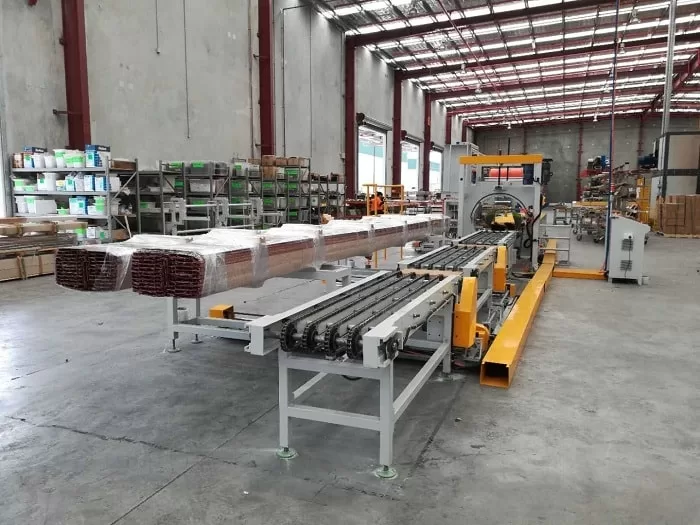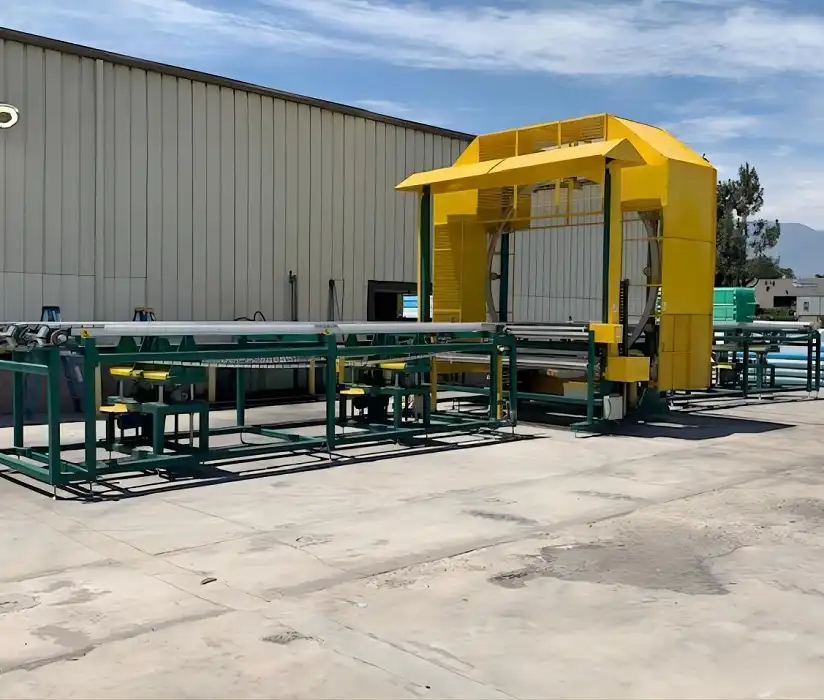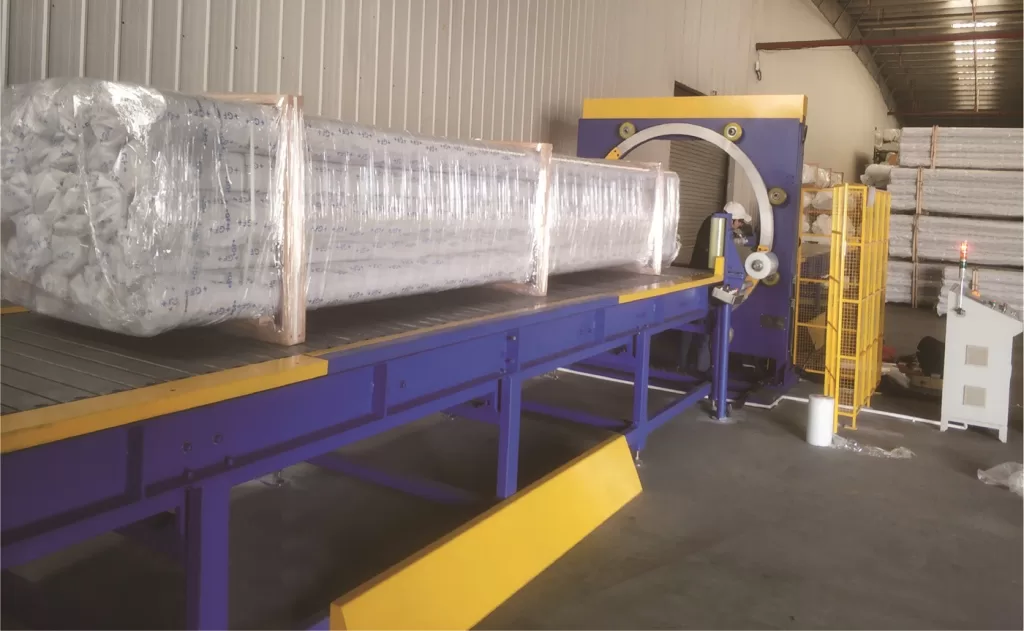Optimizing the Packaging of Long Products: A Guide to Automatic Orbital Stretch Wrappers
Wrapping long, bulky, or irregularly shaped items like metal bars, extrusions, timber, or rolls presents unique challenges in manufacturing and distribution environments. Manual wrapping is often slow, inconsistent, and poses safety risks. Automatic orbital stretch wrappers offer a specialized and efficient automated solution to these challenges.
What is an Automatic Orbital Stretch Wrapper?
An automatic orbital stretch wrapper, sometimes referred to as a horizontal wrapper, is an industrial packaging machine engineered to apply stretch film around the entire circumference of elongated products as they pass horizontally through the machine's wrapping ring. Unlike traditional turntable wrappers designed for pallet loads, the orbital wrapper's film dispensing carriage rotates around the stationary or moving product. Automatic Orbital Stretch Wrappers are specifically designed for items that are difficult or impossible to wrap using conventional methods.
How Orbital Wrapping Works: The Core Mechanism
The process typically involves the following steps:
- Infeed: The product (e.g., a bundle of bars, a single roll, or extrusions) is conveyed into the wrapping zone, often via powered rollers or belts.
- Wrapping Cycle: Sensors detect the product's presence, initiating the wrapping cycle. A rotating ring, holding the stretch film roll and carriage system, orbits around the product.
- Film Application: As the ring rotates, the film carriage dispenses stretch film, applying it tightly and consistently around the product's profile. The product may move continuously through the ring, or the ring itself might traverse the length of a stationary product.
- Film Cut and Seal: Once the product is fully wrapped (or the desired wrap length is achieved), an automated mechanism clamps, cuts, and seals the film tail.
- Outfeed: The securely wrapped product is conveyed out of the machine, ready for storage or shipment.

horizontal orbital stretch wrapper with timber feeder and strapping machine Key Features and Technical Advantages
Modern automatic orbital stretch wrappers incorporate several technologies to enhance performance and reliability:
- Precise Film Tension Control: Advanced systems, often utilizing servo motors or electromagnetic brakes, allow for precise control over the film stretch percentage and application tension. This is crucial for achieving optimal load containment [external link to PMMI resource on load containment or similar authority] without crushing or damaging the product, ensuring consistent wrap quality, and preventing film breaks.
- Continuous Wrapping and Film Management: These machines use large-capacity film rolls and feature automated film clamping, cutting, and wiping/sealing systems. This minimizes downtime required for film roll changes and eliminates the inconsistencies and potential weak points associated with manual film starts and splices.
- Versatility and Adaptability: Orbital wrappers are designed to handle a wide range of product lengths, cross-sectional shapes (round, square, rectangular, irregular), and weights. Many models offer programmable settings and automated adjustments for different product dimensions, enhancing operational flexibility.
- Integration Capabilities: They can be seamlessly integrated into existing automated production or packaging lines, receiving products directly from upstream processes (like cutting or bundling) and feeding them directly to downstream systems (like labeling or palletizing).
Operational Benefits in Fabrication and Manufacturing
Implementing an automatic orbital stretch wrapper yields significant operational advantages:
- Enhanced Product Protection: The complete film coverage shields products from dust, moisture, scratches, and other surface damage during handling, storage, and transit. It significantly improves load stability, especially when bundling multiple items together, preventing shifting and potential damage.
- Increased Throughput and Efficiency: Automation dramatically increases wrapping speed compared to manual or semi-automatic methods. This reduces labor requirements, eliminates packaging bottlenecks, and boosts overall line productivity.
- Improved Workplace Safety: By automating a physically demanding and potentially hazardous task, these wrappers reduce the risks of repetitive strain injuries, cuts from film handling, and accidents associated with maneuvering heavy or awkward loads manually.
- Reduced Material Waste and Costs: Optimized film usage through precise pre-stretch and tension control minimizes material consumption compared to inconsistent manual wrapping. Combined with reduced labor costs and minimized product damage claims, this leads to a lower total cost of packaging. [external link to technical info on stretch film types or properties]

e2400 horizontal stretch wrapping machine2 Considerations for Implementation
When selecting an automatic orbital stretch wrapper, key factors include:
- Product Dimensions and Weight: Ensure the machine's ring size and conveyor capacity can accommodate the largest and heaviest products.
- Required Throughput Speed: Match the machine's wrapping speed (rotations per minute and conveyor speed) to the production line's output requirements.
- Film Specifications: Consider the type and gauge of stretch film required for adequate protection and containment.
- Operating Environment: Factor in space constraints, power requirements, and any specific environmental conditions (e.g., dust, temperature).

1horizontal wrapping machine gg1500 ce approved convey Conclusion
Automatic orbital stretch wrappers represent a critical technology for efficiently and securely packaging long, rolled, or irregularly shaped products common in metal fabrication, plastics extrusion, timber processing, and other industries. By automating the wrapping process, they address key challenges related to product protection, operational speed, workplace safety, and cost-effectiveness. Their ability to provide consistent, high-quality wrapping makes them an indispensable asset in modern, demanding industrial environments seeking to optimize their end-of-line packaging operations.

